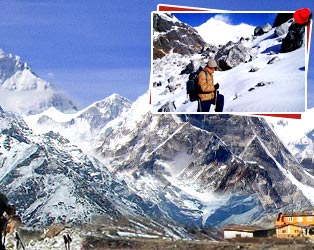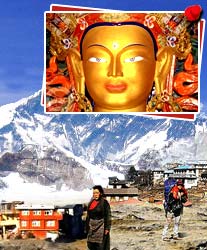Himalayas is known for its historical, religious, and
geographical significance. Historically it has a lot of relevance it
served as a guard from various invasions, a border and a meeting ground
for different races, culture and religion. It formed a divide between
India and Tibet. But that barrier didn't stopped individuals from
pursuing adventurous journeys to explore the unknown side of the
mountains. People traveled for religious and trade purposes. The
trans-Himalayan region was a key center for trade and commerce. With the
famous Silk Route this region first gained importance during the early
Han dynasty i.e. 206 BC to 8 AD. The route connected Central Asia with
South Asia, and created a bridge between culturally and religiously
diverse countries such as India, China, Afghanistan, Nepal, and Bhutan.
Himalayas was also a witness to the Indus Valley Civilization, the
oldest Indian Civilization. In 1856 in the foothills of the Himalayas
the twin cities of Mohenjo-daro and Harappa was discovered. So Himalayas
has a rich historical background to unfold. To explore the Himalayas
innumerable attempts have been made as the Mount Everest has been opened
for commercial mountaineering in the early 1920s. But Tenzing Norgay and
Sir Edmund Hillary have made the first successful attempt to climb the
Everest in May 1953. Since then many successful attempt have been made
to climb the Mount Everest.
Now coming to the origin of Himalayas it can be said that millions of
years ago, a collision between Indo-Australian Plate and the Eurasian
Plate resulted in the formation of the world's highest mountain
Himalayas. There were several steps in the formation of the Himalayas.
The first step was the collision of the Gondwana plate and Angara plate.
The seabed raised into longitudinal ridges and valleys. In the second
step the collision was very effective and powerful. The Tethys bed rose
to a great extent to cause the final retreat of the sea. During this the
Great Himalayas and the Tibetan Himalayas were formed. In the third step
the Lower Himalayas were formed. During the fourth step the Himalayas
ranges elevated and the Sub Himalayas were raised. The last step was the
final phase, which determines the present structure of the Himalayas.
The panoramic view of the mountain ranges attracts traveler across the
world. The early Aryans use to consider Himalayas as the adobe of Gods
and Goddess. In 1852 the highest mountain in the world was named after
Sir George Everest as Mount Everest. Some facts about the Himalayas
expeditions are: As Nepal opened its frontiers in 1949 to the outside
world people explored ten of the fourteen 8000m peaks. Some of the major
among them are
Annapurna (8091m) was the first peak to be climbed in 1950, and then in
1953 it was Mount Everest (8848m) and Nanga Parbat (8125m). From that
time onwards many expeditions have been made and by 1964 all the
Himalayan peaks had been climbed.



